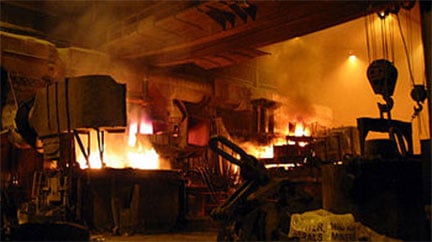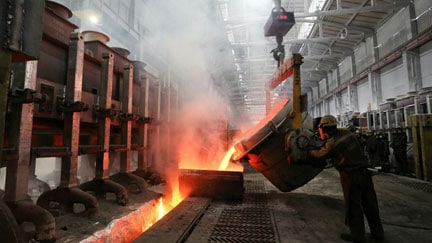Sectors
Metal Production
Steelmaking is the process of producing steel from iron ore and/or scrap. In steelmaking, impurities such as nitrogen, silicon, phosphorus, sulphur and excess carbon (the most important impurity) are removed from the sourced iron, and alloying elements such as manganese, nickel, chromium, carbon and vanadium are added to produce different grades of steel. Limiting dissolved gases such as nitrogen and oxygen and entrained impurities (termed "inclusions") in the steel is also important to ensure the quality of the products cast from the liquid steel.
Steel Production
Steel production has existed for millennia, but it was not commercialized on a in volume until the late 14th century. An ancient process of steelmaking was the crucible process. In the 1850s and 1860s, the Bessemer process and the Siemens-Martin process turned steelmaking into a heavy industry.
Today there are two major commercial processes for making steel, namely basic oxygen steelmaking, which has liquid pig-iron from the blast furnace and scrap steel as the main feed materials, and electric arc furnace (EAF) steelmaking, which uses scrap steel or direct reduced iron (DRI) as the main feed materials.
Oxygen steelmaking is fuelled predominantly by the exothermic nature of the reactions inside the vessel; in contrast, in EAF steelmaking, electrical energy is used to melt the solid scrap and/or DRI materials. In recent times, EAF steelmaking technology has evolved closer to oxygen steelmaking as more chemical energy is introduced into the process.

How Primary Aluminium is Manufactured
Aluminium primary production is the process by which alumina is smelted to pure aluminium metal. The Hall–Héroult process, simultaneously discovered in 1886 by American Charles Martin Hall and Frenchman Paul Héroult, continues as the main industrial process by which primary aluminium is produced. In 1888, Martin founded the first large-scale aluminium production plant in Pittsburgh. The Reduction Company of Pittsburgh later became the Aluminium Company of America, then Alcoa.
Primary production is the process through which new aluminium is made (versus secondary production, in which existing aluminium is recycled into pure metal). Aluminium originates from bauxite, an ore typically found in the topsoil of various tropical and subtropical regions. Once mined, aluminium within the bauxite ore is chemically extracted into alumina, an aluminium oxide compound, through the Bayer process. In a second step, the alumina is smelted into pure aluminium metal through the Hall–Héroult process.
In the Hall–Héroult process, alumina is dissolved in a molten cryolite bath within a carbon-lined steel pot. Carbon anodes are inserted in the top of the bath and an electric current passes through the anodes and the bath. Oxygen atoms separate from the alumina and combine with the carbon anode, leaving the remaining molten aluminium at the bottom of the pot. The molten aluminium is periodically siphoned out and placed in a holding furnace. From the holding furnace, the molten aluminium is cast into an ingot.

Types of Assets Monitored
- Various contracts for undertaking routine condition-based monitoring services, as well as the following specialised services:
- Laser aligning and installing large Mill Stand Gearboxes, involving pre-removal gearbox inspections and then full commissioning of the drive train, with further wireless vibration analysis.
- Crop shear gearbox inspections – using hand tools and boroscopes
- Fan inspections – including vibration analysis, alignment and balancing in situ
- Oil sampling – on various types of assets
- Installation of BlueTooth accelerometer systems on Mill Stand gearboxes and Beam Mill manipulator drives
- Installation of BlueTooth accelerometer systems on Rodding and Cast Plant fans
- Assistance to the steel work engineers rebuilding a Hot Strip Mill Mandrel gearbox, rewriting the procedures for undertaking this work
- Installation of BlueTooth accelerometer system on the Stretch Reduction Mill gearbox
- Commissioning of a Rolling Mill stand drive assembly, comprising of motor, primary and secondary rolling mill gearboxes. Commissioning, included laser aligning, vibration analysis, thermal imaging and oil sampling.
In both the above production facilities we have a wealth of experience for monitoring these critical assets. Generally, these assets are large and can have a great deal of complexity involved. We at DMS are used to working in these environments and have had a lot success in various services provided:-